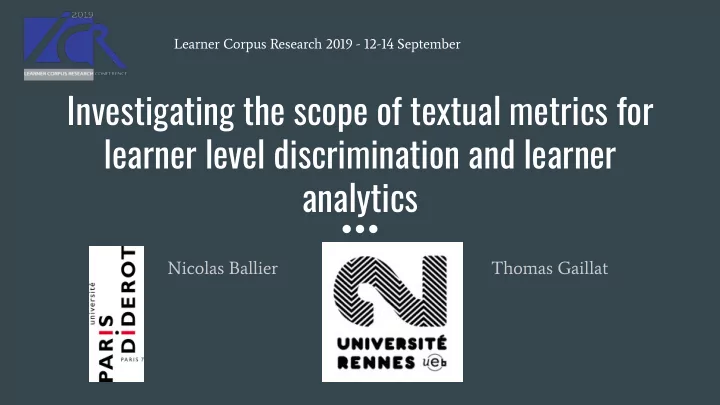

Learner Corpus Research 2019 - 12-14 September Investigating the scope of textual metrics for learner level discrimination and learner analytics Nicolas Ballier Thomas Gaillat
Problem statement Learning a language ● For individuals > requires regular assessments for both learners and teachers For institutions > a growing demand to group learners homogeneously & fast ● Assessment within CEFR framework ● Need for automatic assessment tools 2
Problem statement Automatic Language assessment tools ● Traditional method: labour intensive, short-context and rule-based exercises focus on specific errors or language forms ○ No reverse engineering for feature explanation ○ Supervised learning methods ● Criterial features: Syntactic, semantic and pragmatic ○ ○ Criterial features: complexity metrics Meaningful linguistic feedback for learners ● Scope: word, sentence and text ○ 3
Research Questions ● Which scopes do textual metrics have ? ● Which metrics & scopes can be identified as predictors for CEFR levels? 4
Outline 1. Previous work on language assessment 2. Method 2.1. Corpus 2.2. Annotation and metrics 2.3. Metrics and scopes for feedback 2.4. Processing and data set 2.5. Experimental setup 3. Results 4. Discussion and next steps 5
Previous work in level assessment Converging methods in automatic learner language analysis ● Automatic Scoring Systems for learner language (Shermis et al., 2010; Weigle, 2013) > Shared-tasks: Spoken CALL (Baur et al., 2017) & CAP18 (Arnold, et al. 2018) Automatic learner error analysis (Leacock, 2015) ● ● Automatic learner language analysis: criterial features (Crossley et al, 2011; Hawkins & Filipovi ć , 2012) , complexity metrics (Lu 2010, 2012; Lissón and Ballier 2018) > Our proposal: Criterial features for meaningful feedback to learners 6
Method Corpus ● Annotation and metrics ● ● Metrics and scopes for feedback Processing and data set ● Experimental setup ● 7
Corpus CELVA.Sp (University of Rennes). L2 Corpus of English for Specific Purposes (Pharmacy, Computer Science, Biology, Medicine) French L1 component ● 55 000 word learner corpus ● 282 Written essays of different individuals (students L1 to M1) ● ● Mapped onto the six CEFR levels with DIALANG Number of writings A1 A2 B1 B2 C1 C2 French L1 27 63 125 43 19 3 8
Annotation & metrics Annotation and metrics tools ● TreeTagger (POS tagging) (Schmid 1994) L2SCA (Lu 2010) ● R Quanteda library: texstat (lexdiv & readability) (Benoit 2018) ● Metrics Syntactic e.g. amount of coordination, subordination ● Lexical diversity e.g. density, sophistication ● ● Readability (level of difficulty of a text) 9
Metrics and scopes: a taxonomy for learner feedback ● We classify according to the types of variables used in eah formula 3 exemples ● ARI = 0.5ASL+4.71AWL−21.34 ○ Word.size.characters (one of the variables focuses on word size in ■ relation to characters) Sentence.size.words (one of the variables focuses on sentence size in ■ relation to words) CN/C = Complex Nominals / Clauses ○ ■ Sentence.component.component (one of the variables focuses on a specific sentence component in relation to another) W = Total number of words in a text ○ Text.size.words (one of the variables focuses on text size in relation ■ 10 to words
Metrics and scopes: a taxonomy for learner feedback Word.size.characters: ARI ARI.simple Bormuth Bormuth.GP Coleman.Liau Coleman.Liau.grade Coleman.Liau.short Dickes.Steiwer DRP, Fucks, nWS nWS.2 , Traenkle.Bailer Traenkle.Bailer.2 Wheeler.Smith Word.size.syllables: Coleman Coleman.C2 meanWordSyllables, Farr.Jenkins.Paterson, Flesch Flesch.PSK Flesch.Kincaid FOG FOG.PSK FOG.NRI FORCAST FORCAST.RGL, Linsear.Write, LIW, nWS nWS.2 nWS.3 nWS.4 Wheeler.Smith Sentence.size.words: (n words/nsent) MLS MLT MLC ARI family, Bormuth family, Dale.Chall family, Farr.Jenkins.Paterson Fucks WS.3 nWS.4 Flesch Flesch.PSK Flesch.Kincaid FOG FOG.PSK Sentence.size.characters: Danielson.Bryan family, Dickes.Steiwer, Sentence.size.syllables : DRP ELF Flesch Flesch.PSK Flesch.Kincaid FOG FOG.PSK FOG.NRI RIX SMOG SMOG.C SMOG.simple Strain Sentence.components: Verb Phrase (VP) Clauses (C) T-Units (T) Dependent Clauses (DC) Coordinate Phrases (CP) Complex Nominals (CN) Sentence.components.components: C/S (Sentences) VP/T C/T DC/C DC/T T/S CT CT/T CP/T CP/C CN/T CN/C Traenkle.Bailer family (prepositions & conjonctions) Text.size.words: W Text.size.sentences: S Coleman.Liau family (n sentences/n words) Linsear.Write Text.variation.words: TTR C (Log TTR) R (root TTR) CTTR U S Maas lgV0 lgeV0, Dickes.Steiwer Text.repetitions.types: Yule’s K Simpson’s D Herdan's Vm Text.sophistication.wordsDaleChalList: Bormuth Bormuth.GP Bormuth, Dale.Chall family, DRP, Scrabble Text.sophistication.wordsSpacheList: Spache Spache.old 11
Processing pipeline and Data set Features ● 83 metrics for each text Outcome variable: CEFR levels ● Pipeline 12
Experimental setup Supervised learning approach ● Dataset: Train (80%) and test set (20%) - random selection Method: R RandomForest (ntree = 500, mtry = 6) ● Stage 1: Classification in CEFR levels Stage 2: Feature explanation per CEFR level 13
Results: Stage 1 6 CEFR class classification ● Poor 3 CEFR classes A, B, C precision Recall F1-score A 0.5 0.53 0.51 B 0.84 0.78 0.81 C 0.33 1 1 14
Results: Stage 1 (2) B1 vs B2 class Precision Recall F1-score B1 0.91 0.73 0.81 B2 0.20 0.50 0.28 15
Stage 2: Feature explanation Significant features for B level: ● Root & Corrected & log TTR Complex Nominal (CN) ● Yule’s K ● Dependent clauses/clauses ● ● Number of Words, sentences 16
Results: Scopes and predictability B learners are sensitive to: Metrics Scope Root & Corrected & log TTR Word.density Complex Nominals (CN) Sentence.component Dependent clauses/clauses Sentence.component.component Number of Words, sentences Text.size.words Text.size.sentences Yule’s K Text.repetitions.types 17
Discussion Linguistic features correlate with levels which gives and insight in Interlanguage. Features linked to scopes can be used to advise learners. But... Refine scope taxonomy Binary classification in 2 levels: beginner (A1,A2,B1) and advanced (B2,C1,C2) More metrics: Syntagmatic relationships in ratios BUT what about features based on paradigmatic relationships ? 18
Next steps More L1s, features & texts for training and testing ● ● Linguistic microsystems as metrics Building an online system for CEFR prediction (Ulysses PHC project: Universities ● of Paris Diderot and Insight NUI Galway Ireland) 19
Thank you thomas.gaillat@univ-rennes2.fr nicolas.ballier@univ-paris-diderot.fr 20
Recommend
More recommend